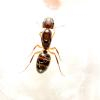Thanks to everyone who read this and especially to those who contributed to their identification. I never would have guessed Lasius, which is odd because I have had several different lasius species before.
I'm disappointed. It seems that half the queens I catch are parasites. It makes me wonder if some parasitic queens invade a nest only to find they're up against another parasitic queen that has already taken over the colony. What a wasted hunt, eh?
Switching topics, which of those pictures was most helpful in the identification process?
Parasitic queens (such as L. claviger, L. umbratus, L. latipes etc.) are usually much bulkier than fully claustral queens, and their gasters tend to be on the smaller side. Identifying a parasitic Lasius queen is a whole different ball game from identifying a fully claustral one.
Some queens are actually capable of parasitizing already parasitized colonies. For example, Lasius interjectus has been known to infiltrate colonies of Lasius claviger.
In general, I would say the more pictures the better. Usually it's hard to know exactly what angles you might want for a certain species, especially if you don't know what the species is, so it's worth taking as many as possible. I think the profile and head shots of the mandibles and from the top were the most useful in this case.
BatSpiderfFish is definitely your go-to guy for social parasite related questions. He'd be great to talk to.






















